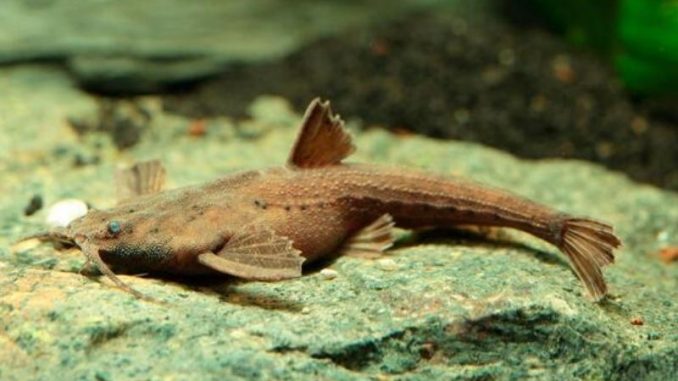
The banjo catfish is a freshwater fish of the catfish group. The fish has an unusual banjo-shaped body with sandy-brown or black coloring. Banjo catfish are popular with aquarists due to the fish’s peaceful personalities, although these reclusive fish are known to hide from view until they feel completely comfortable in the tank.
TABLE OF CONTENTS
Banjo Catfish Facts & Overview
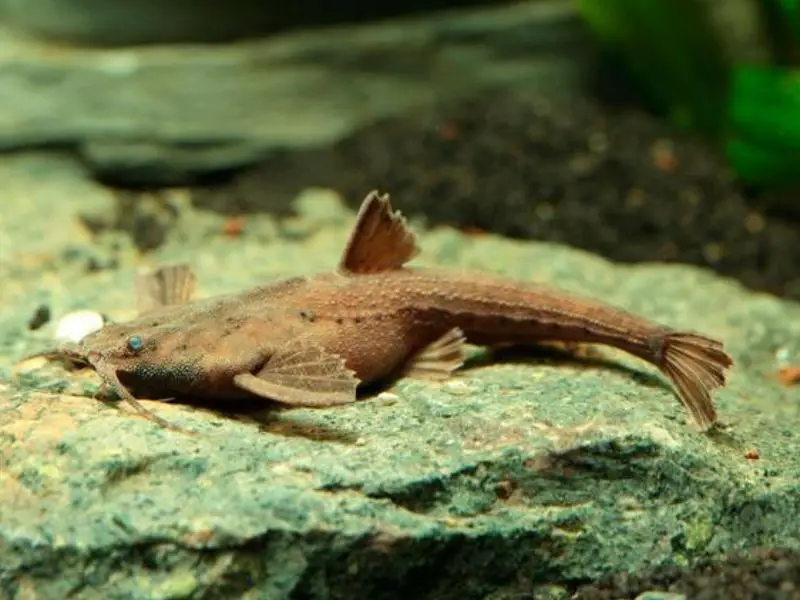
| Scientific name: | Bunocephalus coracoideus |
| Common names | Banjo catfish, banjo fish, guitarrita catfish, burrowing catfish |
| Distribution: | Brazil, Bolivia, Peru, Uruguay |
| Size: | 5–6 inches |
| Life expectancy: | 10–12 years |
| Color: | Earth-toned — brown, orange, and black |
| Diet: | Omnivore |
| Temperament: | Peaceful |
| Minimum tank size: | 25 gallons |
| Temperature: | 75–82°F (24–28°C) |
| pH: | 6.0–8.0 |
| Hardness: | 15–20 dGH |
| Care level: | Easy |
| Breeding: | Egg layer |
Origin
Banjo catfish originate in freshwater forest streams, ponds, and lakes in Peru, Bolivia, Uruguay, and Brazil. The fish’s natural habitat is typified by large amounts of debris, such as fallen branches and leaf litter. Banjo catfish are found abundantly in the wild, but they’re difficult to spot — their tree bark-like appearance enables them to blend in with the debris at the bottom of the riverbed.
Adult Size & Lifespan
The average length of a full-grown banjo catfish is 5–6 inches. Males and females are similar in length, but females look plumper than males when viewed from the side.
In the wild, banjo catfish live for 12 years on average. Most banjo catfish live for 8–12 years in captivity when properly cared for.
Availability
Banjo catfish aren’t as widely available as other catfish species, and though the banjo species is listed on most online pet stores, the fish are not always in stock. The typical cost of a banjo catfish is $7–$10.
Reputable stores selling banjo catfish are:
Appearance & Behavior
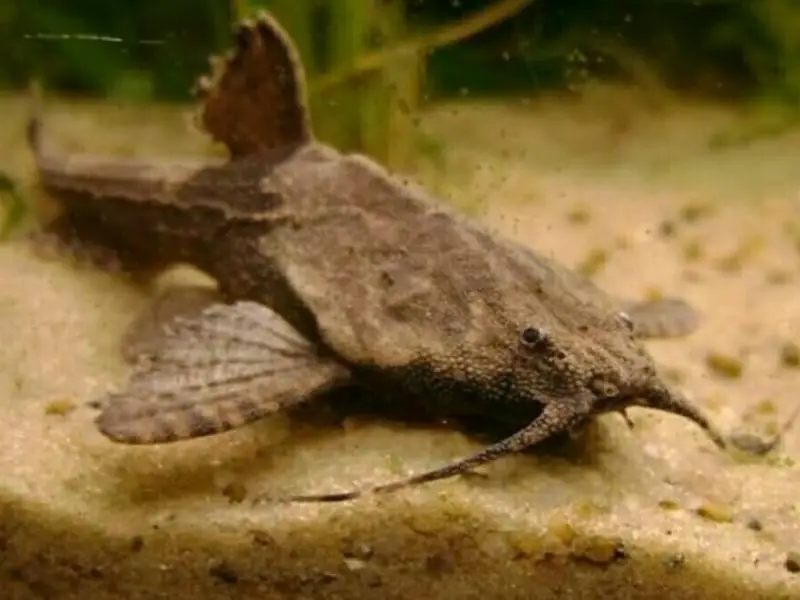
The banjo catfish’s body is a darkly colored body and blends in with its natural surroundings. This bottom-dwelling fish is shy and reclusive.
Colors, Patterns, Fins, and Sex Differences
Banjo catfish are named after their body shape, which resembles a banjo guitar. The fish have long, slender bodies that decrease in thickness toward the tail, and the fish have wide, flat faces used for burrowing in the sand.
This type of catfish has heavily keratinized skin with a rough, bumpy appearance and texture. The fish’s coloring is earth-toned, such as brown, black, and light tan, with black splotches along the tail and light-colored speckles across the whole body.
Male banjo catfish are slimmer and darker than females. Ageing, disease, and stress cause banjo catfish’s colors to become duller and paler than normal.
Typical Behavior
Banjo catfish are passive, peaceful fish that get along well with many other similar species. The fish aren’t territorial — in fact, they’re most confident in the company of fish of their kind and feel most comfortable in groups.
The banjo catfish is slow-swimming and spends most of its time burrowing in the substrate for food. The fish is easily startled and is known for hiding in caves, behind plants, or in the substrate during the day, especially when first introduced to an aquarium.
Banjo catfish are nocturnal, so they’re most active during the night, and sleep partially buried in the substrate during the day.
Banjo Catfish Tank Requirements
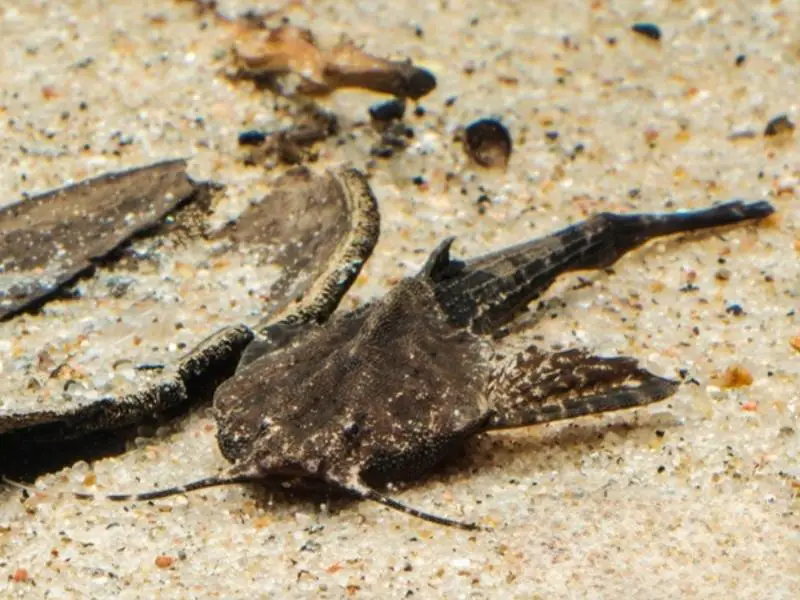
Banjo catfish are easy to look after as long as you make the fish feel comfortable with friendly tank mates and a habitat that mimics the species’ natural environment.
Habitat and Tank Setup
The banjo catfish’s natural habitat is freshwater lakes, rivers, and ponds that have a high concentration of debris, organic material, and plant matter. Replicate this habitat in captivity with suitable decorations and water parameters.
Banjo catfish spend a lot of time digging in the substrate, so the substrate should be soft and non-abrasive, such as soft sand or fine gravel. Decorate the tank with driftwood, rocks, dried leaf litter (such as dried Indian almond leaves), and caves to allow the fish to blend in with its surroundings.
Large broad-leafed plants, like duckweed and water wisteria, can be used to provide the banjo catfish’s preferred dimly-lit environment. Optionally, install blue moon lighting that switches on in the evening before the main lights switch off, to observe the fish in their preferred subdued lighting.
Banjo catfish should be kept in a tank of at least 25 gallons.
Tank Conditions
Ideal tank conditions for a banjo catfish are:
| Water type | Neutral, slow-moving freshwater |
| Tank size | Minimum 25 gallons and an extra 10 gallons per additional banjo catfish |
| Water temperature | 75–82°F |
| Substrate | Soft sand or fine gravel |
| Tank setup | Driftwood, rocks, plants, caves, leaf litter |
| Acidity | 6.0–8.0 pH |
| Water hardness | 15–20 dGH |
| Filter | Yes, to clean the water and provide a slow current |
| Bubbler | Not essential if the tank contains a good filter |
| Lighting | Standard aquarium lighting and blue moon lighting (optional) |
| Water heater | Yes |
Banjo catfish are hardy fish that accept various water conditions as long as extremes are avoided. The tank water should be clean, so a good filter is the most important feature in a banjo catfish tank.
Common Banjo Catfish Health Issues and Diseases
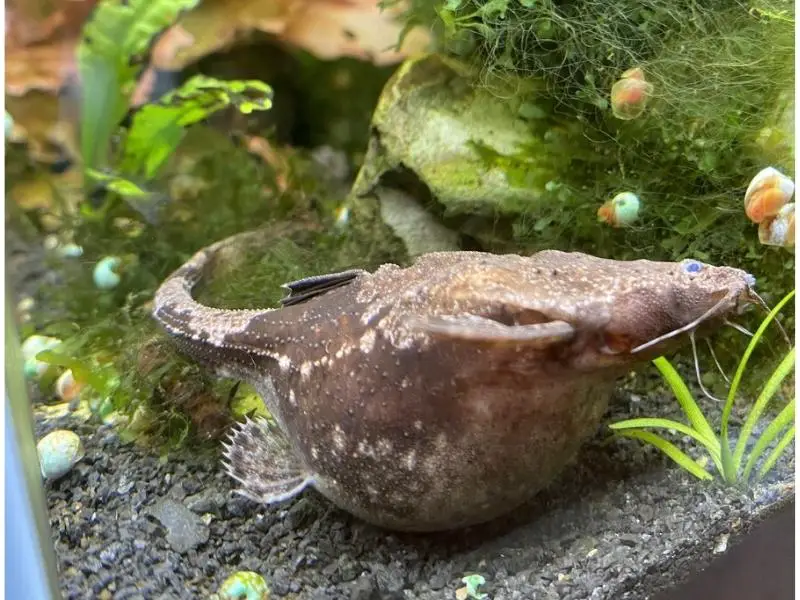
Some of the common health issues and diseases affecting banjo catfish are listed in the table below.
| Health Issue | Symptoms | Suggested Action |
| Ammonia poisoning | Darkened body color, gasping for breath, lethargy, loss of appetite | Perform a large water change and discuss medication with your veterinarian |
| Bloat | Swollen abdomen, lethargy, pale gills | Monitor the fish’s diet and reduce its access to food to prevent overeating |
| Skin injuries | White patches on the skin | The injury should heal on its own without treatment. Remove abrasive substrate or rough decorations that could lead to further injuries as the catfish as it burrows |
Banjo Catfish Tank Mates
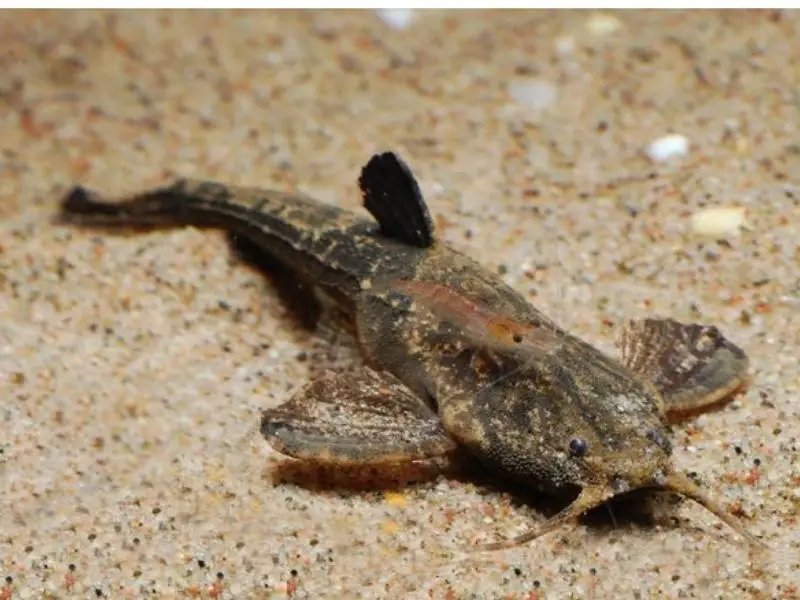
The best tank mates for banjo catfish are small, peaceful, slow-swimming fish that won’t bully or try to eat the catfish.
Great tank mates for banjo catfish include:
- Other banjo catfish
- Corydoras
- Hatchetfish
- Zebrafish
- Tiger barbs
- Betta fish
- Guppies
- Small tetras
Banjo Catfish Diet and Feeding
In the wild, banjo catfish eat a variety of foods, including earthworms, bloodworms, and small insects. Mimic this diet in captivity to ensure the fish is well-fed.
Feed banjo catfish in the evening, when the fish emerge from their shelters looking for food. Provide a pinch of small, meaty live or frozen foods like black or white mosquito larvae, bloodworms, daphnia, and brine shrimp. Supplement the fish’s diet with high-quality sinking catfish granules or pellets.
Ensure the fish have enough food to continue eating for two minutes. Avoid overfeeding to reduce the risk of health issues like bloat.
Breeding the Banjo Catfish
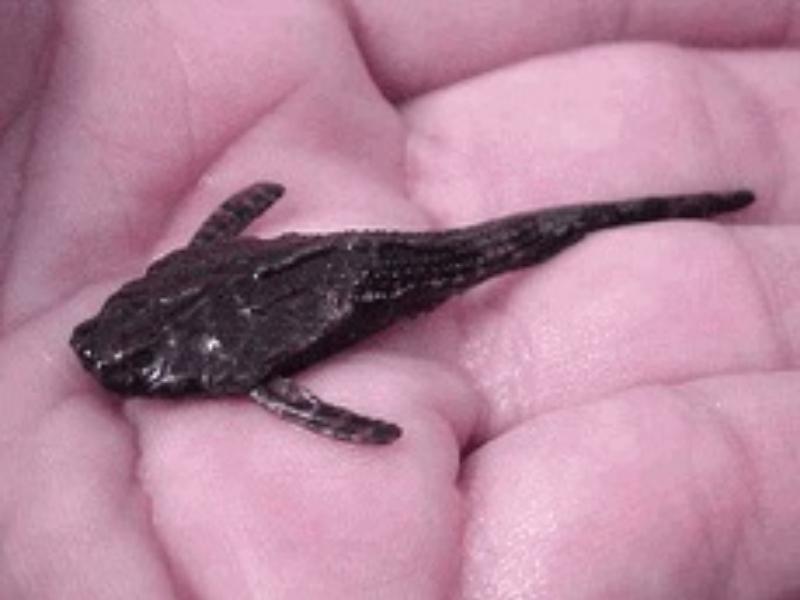
Breeding banjo catfish in captivity is difficult and has only been successfully accomplished by some professional breeders. Limited information is available on the exact steps required to breed these fish.
Banjo catfish reach sexual maturity once they’ve grown to about 4 inches long. The general breeding process for these fish is:
- Ensure there are several males and females together in the same breeding tank. Catfish are known to breed in the summer, so consider increasing the water temperature by 1 or 2 degrees to induce spawning
- Wait for the fish to spawn overnight. The females scatter up to 300 small, green, and sticky eggs on the substrate
- Wait for about three days for the eggs to hatch. The young larvae will feed off the egg sacks
- Feed the fish cyclops and rotifers, and ensure that the water quality is as clean as possible. The juveniles will begin to develop their coloration after about five days
- Move the juveniles into their own tanks and feed them an adult fish diet after three to five months
Should You Get a Banjo Catfish for Your Aquarium?
Banjo catfish are peaceful, shy fish with a unique appearance and interesting burrowing behavior. Consider getting a banjo catfish if you have a suitable tank setup with peaceful tank mates. Don’t get a banjo catfish if your tank contains aggressive or large fish that could bully or eat the catfish.
Despite their nervous dispositions, banjo catfish make a great addition to most community tanks and are enjoyable to watch once they gain confidence in captivity.
Banjo Catfish FAQs
Can a Banjo Catfish Live With Other Fish?
Yes, a banjo catfish can live with other fish, but not all fish are good tank mates for banjo catfish. The banjo catfish species should be housed with similarly-sized, peaceful tank mates such as corydoras, hatchetfish, and small tetras. Don’t house banjo catfish with intimidating fish, such as aggressive, large, or fast-moving fish.
How Big Will a Banjo Catfish Get?
A banjo catfish will grow as big as 6 inches in the wild and in captivity. Male and female banjo catfish grow to equal size, but males look slimmer than females when viewed from the side. Banjo catfish are one of the smallest catfish species, so they’re a good choice for tanks with limited space.
Are Banjo Catfish Peaceful?
Yes, banjo catfish are peaceful, and you can safely house banjo catfish with other similarly-sized peaceful fish species. Banjo fish don’t display aggressive behaviors such as chasing and fin-nipping. Banjo catfish are reserved and usually hide from conflict.
Can Banjo Catfish Live Alone?
Yes, banjo catfish can live alone. However, the fish are most comfortable living with other banjo catfish. House at least three banjo catfish together if you want your fish to display the most confident behavior.
Do Banjo Catfish Eat Algae?
No, banjo catfish don’t eat algae. In the wild, banjo fish mainly feed on earthworms and bloodworms, and the fish require a similar diet in captivity. If you’re looking for fish with tank-cleaning abilities, consider loaches, snails, and corydoras instead of banjo catfish.
Do Banjo Catfish Eat Snails?
Yes, banjo catfish are known to eat snails. The fish enjoy a diet of invertebrates and eat anything that fits into their mouths. Avoid housing banjo catfish in a tank containing snails to prevent the fish from eating the snails.

Be the first to comment